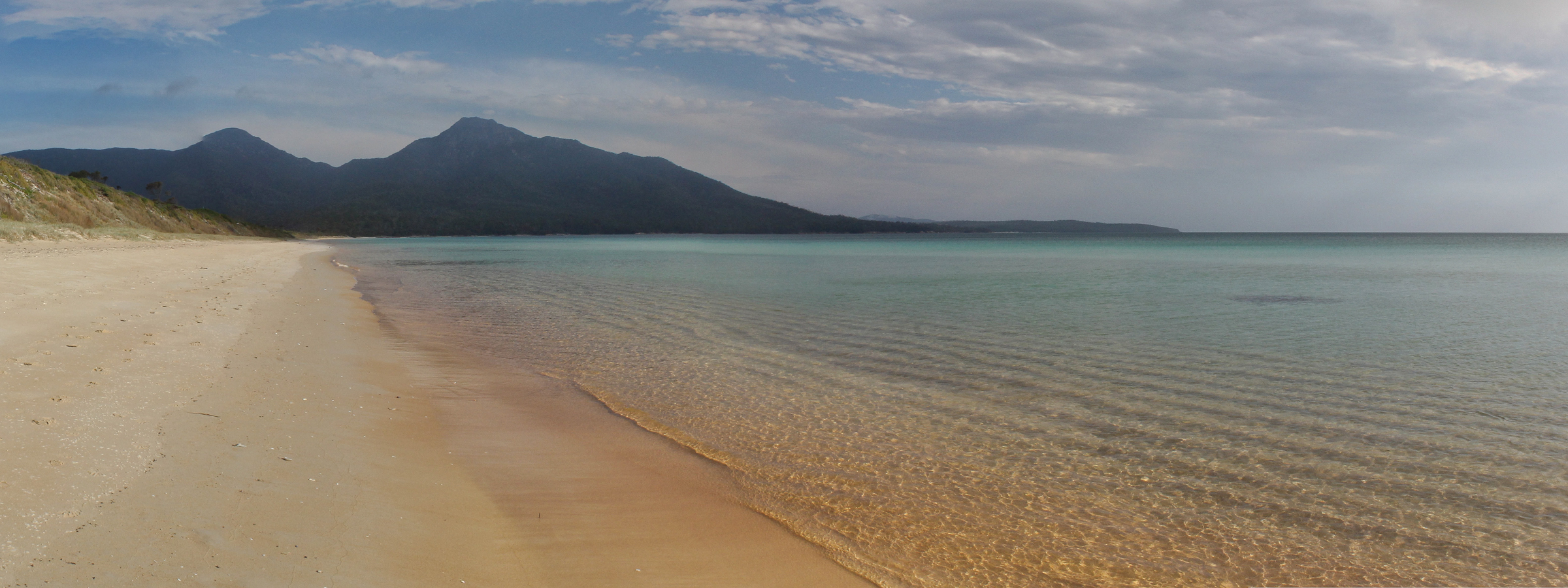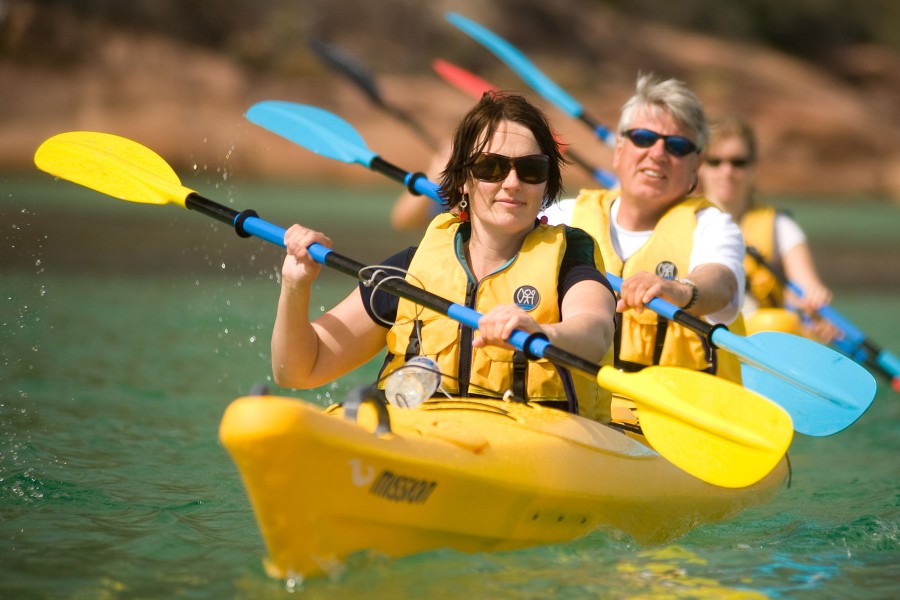Freycinet National Park Visitor Centre
Visit the Freycinet National Park Visitor Centre for your information on things to do in the park. This includes the various walks that range from short walks to multi-day walks. The Visitor Centre also takes bookings for camping. The Park Shop sells park passes and a range of products from books to clothes and other outdoor gear. For further information visit Freycinet National Park at the Parks and Wildlife website: www.parks.tas.gov.au
Walks
Wineglass Bay Lookout – 1 hour return: The short but steep track provides for great views over Coles Bay before reaching the Lookout and the iconic views of Wineglass Bay.
If you want to walk on the white sandy beaches or wade through the crystal clear waters, then Wineglass Bay can be reached in 2 ½ hours return from the carpark.
Wineglass Bay/Hazards Circuit – is a half day walk that takes in Wineglass Bay and Hazards Beach, the walk then follows the coast around the Hazards and back to the carpark. This walk takes approximately 4 ½ hours to complete.
Mt Amos – The more strenuous 3 hour return walk up Mt Amos provides for spectacular views of Wineglass Bay and the Freycinet Peninsular. This is a steep and demanding track over steep slabs of bare rock, appropriate footwear is required and the track is very slippery and dangerous after rain.
Cape Tourville: A sealed road from Coles Bay leads to a boardwalk track around spectacular cliff tops and a lighthouse. The walk provides views of the rugged eastern coastline of the Dreycinet Peninsular. It is a great site to observe whales and provides a glimpse back into Wineglass Bay.
Sleepy Bay: On the way to Cape Tourville is Sleepy Bay. This is a 10 minute return walk to a viewing platform, or a 30 minute return walk to Gravelly Beach.
Friendly Beaches: The Friendly Beaches are a long stretch of white sandy beaches that provide great opportunities for long beach walks, fishing and surfing. There is camping at Isaacs Pointwith basic facilities and please note there is no water available.
Freycinet National Park – Flora and Fauna
Freycinet National Park is one of four major East Coast reserves that provide a major contribution to the reservation of dry sclerophyll (hard leafed) vegetation communities. Some common plants that you may see are:
Banksia – (Banksia marginata) also known as Honeysuckle Banksia, it has a bright yellow flower that occurs throughout the year.
Tasmanian Blue Gum – (Eucalyptus globulus) is the states floral emblem, it is common on the peninsular usually identified by its bluish gumnuts lying on the ground.
Oyster Bay Pine – (Callitris rhomboidea) is a native pine that is endemic to the East Coast of Tasmania.
She-oak – Three types of Allocasuarina are found in the area; Bull Oak, Coastal She-oak, and Drooping She-oak.
White Kunzea – (Kunzea ambigua) was used by early settlers for tea, when flowering in the spring they give off a pleasant honey scent.
Orchids – There are at least 43 different species of orchid found in the park. Of conservation interest are the; Horned Orchid and the Rusty-hooded Orchid.
The park also has Phytophthora Root Rot (Phytophthora cinnamomi) – This is a fungus that attacks and kills many native plants and is easily spread by humans; either on footwear, or by car and bicycle tyres. Head to the Parks and Wildlife Tasmania website for up to date information.
Some of the local fauna includes:
Wallabies – Bennett’s Wallabies and Tasmanian Pademelon are commonly seen in the area.
Possums – The most common is the Brush Tail, also present: Ring Tail, Pygmy and the introduced Sugar-glider.
Quolls – Eastern Quoll are common in the Park, while the spotted tail Quoll is harder to see.
Tasmanian Devil – The population on the Freycinet Peninsular has suffered greatly due to the Devil Facial Tumour Disease, catching a glimpse of these shy animals is rare.
Echidna – It is possible to see these during the day foraging for ants.
Wombats – Mostly nocturnal and live in burrows up to 20m deep.
Rodents – There are the native Swamp Rat and Water Rat, while the New Holland Mouse is also present at Freycinet.
Bats – There are also a variety of bats, the most common being the Lesser Long-eared Bat and the Little Forest Vespadelus (or Eptesicus).
Marine Mammals:
Bottle-nose Dolphins – There is a local pod that is often seen at Wineglass Bay and occasionally in Coles Bay.
Australian Fur Seal – There are seal colonies on Schouten Island and Ile des Phoques (that is found between Schouten and Maria Islands). Seals may also be seen hauled out on the rocks around Freycinet Peninsular and at times along the east coast beaches.
Whales – Whales are often seen during there annual migration, usually seen on the eastern side of Freycinet Peninsular. The whales seen here are more commonly the Southern Right Whale and Humpback Whale, less frequently sighted are Pilot Whales.
Birds:
Wedge-tailed Eagle – The Tasmanian population is a separate sub species to mainland Australia and is listed as endangered.
White-breasted Sea Eagle – Another large raptor that lives predominantly in coastal areas. Both the Wedge-tailed and White-breasted Sea Eagle nest and breed within Freycinet National Park.
Peregrine Falcon – This bird has occasionally been spotted at White Water Wall.
Waders – Hooded Plovers and Pied Oystercatchers are a couple of the waders that breed along Freycinet’s beaches they nest just above high water and the eggs are camouflaged to blend into the sand, making them prone to trampling by walkers.
Silver and Pacific Gulls – are commonly seen in the area. The Pacific Gull is large and strikingly coloured gull with a prominent red tipped beak.
Crested Tern – Roughly the same size as a Silver Gull, it is distinguished by a vivid yellow beak and black head with a short crest. They are often seen diving for fish in the Freycinet area.
Short-tailed Shearwater (Mutton Bird) – This migratory bird visits Australia between September and May. In between it flies to the north Pacific and the Bearing Sea. It returns to Australia in the summer to breed.
Australasian Gannet – The best place to see Gannets is off of Cape Tourville where they can be seen diving for food from a great height.
Little Penguins – Little Penguins are also regular visitors to the Freycinet area.


